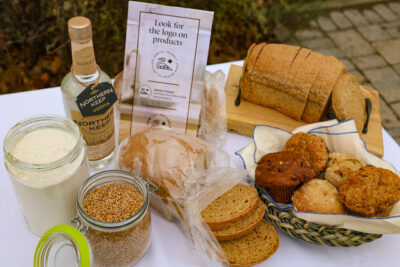Ecolabel program has wheat producers helping waterfowl
By Al Beeber - Lethbridge Herald on November 18, 2021.
 Photo Courtesy Cereals Canada
Habitat-Friendly Winter Wheat Ecolabel Program includes products made from winter wheat, a crop which provides sustainable habitat for waterfowl and upland game birds.
Photo Courtesy Cereals Canada
Habitat-Friendly Winter Wheat Ecolabel Program includes products made from winter wheat, a crop which provides sustainable habitat for waterfowl and upland game birds.
Al Beeber
LETHBRIDGE HERALD
abeeber@lethbridgeherald.com
A new initiative promoting winter wheat may have benefits for southern Alberta farmers and wildlife.
The Habitat-Friendly Winter Wheat Ecolabel Program is a joint venture involving Cereals Canada, Ducks Unlimited and the Prairie Wheat Growers, as well as millers and food processors.
The partnership will help meet consumer demand for sustainable food products while supporting farmers and providing habitat for ducks and other birds.
Gary Stanford, who farms just north of Magrath, said this week Ducks Unlimited discovered about 20 years ago that fields growing winter wheat provided sustainable habitat for a range of game birds.
Pintail duck populations, which Stanford says commonly nest on and near the Milk River Ridge, were in serious decline about 20 years ago.
Unlike hard red spring wheat, winter wheat is seeded in late August or early September. It grows for about four to five weeks, coming up a couple inches out of the soil and uses snow for winter moisture. In October and November, the wheat vernalizes – meaning the plant gets the signal to flower the following spring – and it hardens off for the winter.
It’s harvested at the end of July and early August.
Products that want to use the Ecolabel must contain a minimum of 30 per cent winter wheat.
“I’ve been on the Alberta Wheat Commission for years and years because I grow a lot of winter wheat and there’s a lot grown in Southern Alberta. We’ve been looking for extra markets for it all the time,” including locally and overseas, said Stanford.
“A lot of it went into the feed market or it went into a cheaper price that went overseas. So that’s from the farmers perspective.
“Ten or 15, 20 years ago, Ducks Unlimited realized winter wheat was very sustainable for waterfowl and upland game birds to nest in,” he said. This is due to the fact farmers aren’t disturbing the soil.
“So that’s when Ducks Unlimited kind of got involved with the wheat commission in Alberta and Saskatchewan and Manitoba. So we started kind of doing projects together with winter wheat from the farmers perspective and from the wildlife perspective.
“The pintails like to nest on the Milk River Ridge and just off the Milk River Ridge. This is where a lot of winter wheat is grown,” he said, so this area was ideal for a project such as this.
A lot of flour is made with spring wheat and not as much with winter wheat, he said.
“We decided ‘how can we find a better market for it?’ Stanford said. One way was to work with flour mills.
“We got together with the Alberta Wheat Commission and Cereal Canada and with Paul Thoroughgood from Ducks Unlimited and we started working together because winter wheat is quite sustainable because we’re not doing any farm work in spring. And then also it helps with the nesting grounds. So now with the Ecolabel, it’s going to be on packages but it must have 30 per cent winter wheat in it,” he said of products that are allowed to use the label. Thoroughgood is a Ducks Unlimited agrologist and Saskatchewan farmer.
“With the Ecolabel what we wanted to do was work with flour mills and other products that could come out then that way, it gets the Ecolabel on it. And that way the Ecolabel would tell people we’re trying to be sustainable and help wildlife as much as we can. And that way it’s a market for farmers, it supports wildlife and also it supports the millers,” Stanford said.
Canadian spring wheat, he said is “the best wheat for milling that is grown in the world,” but winter wheat is important for Southern Alberta and southern Saskatchewan.
“We want to be able to have more markets and that way it supports the environment, it supports the wildlife and it supports the farmers,” Stanford said.
Follow @albeebHerald on Twitter
5-4


